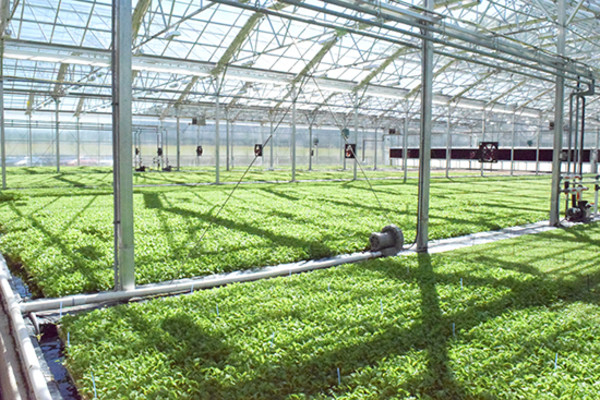Why One National Food Brand Has Local Produce on the Brain

BrightFarms CEO Paul Lightfoot has it in mind to outdo big food companies by offering grocery stores in places like Philadelphia something California companies can’t: Local produce.
Supermarkets certainly see the increased demand for local food but they’re set up to make big orders from a single supplier. So they’re losing money to farmers markets where consumers shop for local produce and meat.
To Lightfoot, this leaves grocery stores with no one to turn to except industrial agriculture companies that grow no closer than the other side of the country. That’s where BrightFarms comes in. The New York City-based company builds greenhouses near the supermarkets they distribute to. Lightfoot envisions starting as a reliable supply of local produce for supermarket chains in the Midwest and Northeast.
“I’ve never seen such a wide open market,” Lightfoot said. “You have a world where people don’t trust big food brands, long complex supply chains. When they go to supermarkets, that’s all there is.”
He’s not the only one who sees grocery stores as the next frontier for the local food movement. Across the country, small farmers and advocates are trying to enter the wholesale market, which also includes restaurants.
Violet Stone of the Cornell Small Farms Program is working with others to put together a curriculum that, eventually, will help small farmers in New York determine if they want to move into a wholesale market.
“What’s very constant is the demand,” Stone said. “Every mega corporation is jumping on the bandwagon.”
A lot of challenges stand between small producers and grocery store shelves, but they’re looking into the idea because many farmers market regulars are burned out in the direct market model. Farmers markets continue to gain popularity but farmers aren’t making as much money as they once did, Stone said.
Volume, timing, and food safety are just a few of the challenges.
To get into grocery stores, small producers may need to narrow the number of crops and livestock they raise so they can focus and increase their supply. The answer may include partnering with other local producers and forming a “food hub,” so wholesalers can go to one place to buy from multiple purveyors.
They also need to find ways to reliably provide high quality products that will last on the shelf while abiding by food safety protocols grocery stores expect from suppliers.
It’ll take years to figure out the best methods – and whether wholesale is even a viable option for small farmers, Stone said.
By then, BrightFarms could have more than 20 farms up and running. She said she’s partial to small farmers – and so are many other diehard local foodies. The food industry has room for everyone, she said.
Lightfoot says he’s not competing with small farmers. Rather, the markets he’s working with “for the most part, none of them are buying local greens,” he said. “It’s almost entirely large, centralized West Coast buyers. It’s them we’re pushing off the shelves and never small farmers.”

The first BrightFarms operation, an hour north of Philadelphia, grows greens (spring mix, baby arugula, baby kale, baby spinach) and basil for McCaffrey’s Market and the Great Atlantic and Pacific Tea Company in 46,000-square-feet of growing space.
Jason Jackson started as the head grower there in July. Before joining BrightFarms, he worked at a 50-acre greenhouse in New York state, growing tomatoes that were shipped all over, including Florida and Ohio. He likes the company’s mission to grow food that is harvested, packed, shipped and set before the consumer within 24 hours.
Though BrightFarms is a national brand, its farms work with local suppliers. Jackson said the Pennsylvania operation is “as local as possible,” from the fertilizer that comes from Allentown, Pennsylvania, to the waste that goes to nearby farmers for compost.
“The idea of BrightFarms was very intriguing. It’s so different from what everyone else is doing,” Jackson said, “and it’s working.”
BrightFarms grows hydroponically in greenhouses in order to grow year-round in climates that otherwise wouldn’t allow it.
“Since we’re growing in places where there’s perhaps less land available … it’s more resource-efficient than the supply chain we’re replacing,” he said. “The challenge is its very capital-intensive. It turns out we’re building greenhouses that cost about $10 million to build. It’s out of reach for most farmers.”
To make it happen, BrightFarms relies on investment. The company recently snagged more than $13 million from prominent investment firms to build the farm near Chicago. It also is expanding to farms near Washington, D.C., and Kansas City, Missouri. Lightfoot wants to see that grow to 20 markets by 2020.
On a side note, Lightfoot rejects the idea that produce grown in greenhouses is less nutritious or desirable than produce grown in soil. He pointed to research that suggests greenhouse-grown food is more nutritious, if only to say that there are counterarguments out there.
He didn’t walk into BrightFarms with “a religious devotion to greenhouses,” but he also isn’t new to foodie culture. He moved into the food industry after about a decade of pursuing local, plant-based eating with his family. Now, he says the produce BrightFarms brings to stores is tastes and looks delicious, especially compared to the stuff picked early and bred to stand up to cross-country travel.
“Local food on a commercial scale – those words haven’t gone together before,” Lightfoot said. “We’re not the only solution here. Momentum is what matters.”
Related on Organic Authority
Costco Refuses to Sell GMO Salmon in its 474 Warehouse Stores
Foodies Are Taking Over Your Grocery Store – And That’s a Good Thing!
Underwater Greenhouses Grow Gorgeous Pesticide-Free Food
Photos via BrightFarms

